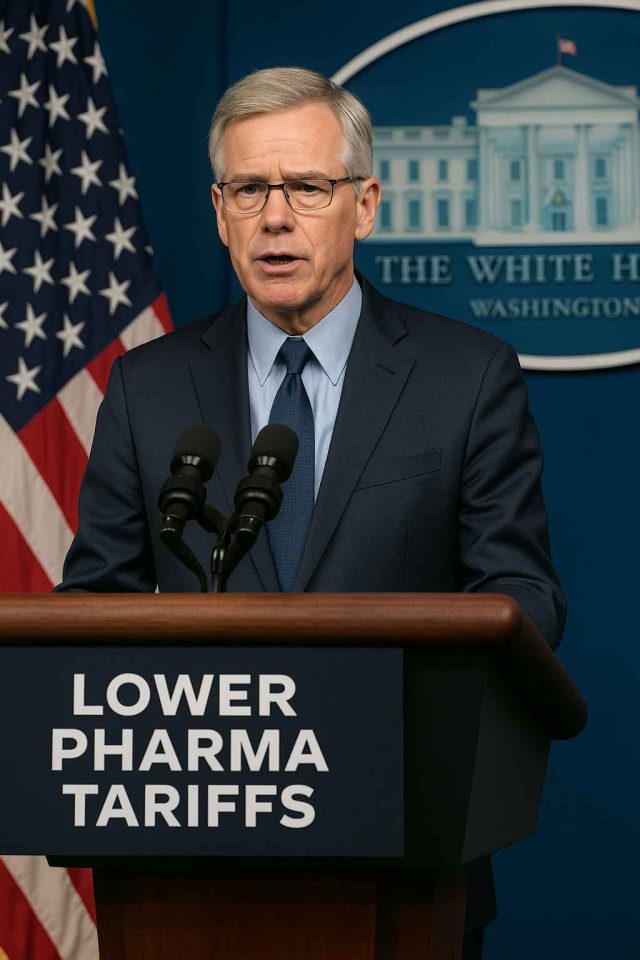For years, global trade disputes and tariff hikes have created challenges for the pharmaceutical supply chain. Now, with the White House signaling a move toward Lower Pharma Tariffs on select products, the landscape for drug pricing and international commerce may be about to shift. Could this policy adjustment reduce costs for patients and improve global collaboration, or will it raise new questions about market competitiveness?
Table of Contents
- Why the U.S. Is Considering Lower Pharma Tariffs
- Impact on Pharmaceutical Supply Chains and Pricing
- Opportunities for Drug Manufacturers and Marketers
- Challenges, Limitations, and Global Trade Dynamics
- Conclusion
- FAQs
Why the U.S. Is Considering Lower Pharma Tariffs
The White House’s recent announcement highlights a more flexible stance on pharmaceutical trade. Lower Pharma Tariffs for certain drug categories, including generics and active pharmaceutical ingredients (APIs), could ease cost pressures on health systems. Policymakers argue that reduced trade barriers are essential for maintaining a resilient supply chain, especially after pandemic-era shortages.
This move reflects broader economic priorities. For instance, lowering tariffs on insulin or cardiovascular medications may provide relief for both patients and payers. In addition, such adjustments could improve access to branded drugs like Humira or Eliquis in global markets, where pricing remains a significant hurdle.
Transitioning toward tariff reductions also aligns with U.S. diplomatic efforts. By opening the door to negotiations, the administration signals an intent to cooperate with trade partners, particularly in Asia and Europe. This strategy may help rebuild trust with allies while supporting domestic manufacturing incentives.
Impact on Pharmaceutical Supply Chains and Pricing
Pharma supply chains are notoriously complex, often involving multiple countries for raw materials, manufacturing, and distribution. Lower Pharma Tariffs could reduce friction across this ecosystem, making it easier to import and export critical ingredients. As a result, patients may benefit from more consistent availability of therapies.
Price stability is another potential benefit. For example, APIs sourced from India or China often face tariff-related cost increases that trickle down to consumers. Reducing these trade costs could lead to more predictable pricing for generics and biosimilars, supporting long-term affordability.
However, the impact will depend on implementation. If only specific products are eligible, the broader effect on drug prices may be limited. Additionally, branded drugs like Ozempic or Trulicity may not see immediate cost benefits, since pricing strategies often extend beyond tariffs. Nevertheless, any reduction in trade-related costs is a step toward easing patient financial burdens.
For in-depth perspectives on pharma marketing trends, see Pharma Marketing Network’s featured articles.
Opportunities for Drug Manufacturers and Marketers
The policy shift could present new opportunities for pharmaceutical manufacturers. By lowering tariffs, companies gain greater flexibility in sourcing ingredients and distributing finished products internationally. This not only improves margins but also encourages innovation in areas such as specialty drugs and biologics.
For marketers, the announcement offers strategic openings. Lower Pharma Tariffs may allow brands to reposition themselves as patient-centric by emphasizing affordability and access. Campaigns can highlight reduced costs as part of a broader commitment to health equity. Digital marketing platforms, including EHealthcare Solutions, can amplify these messages to reach healthcare professionals and patients.
Emerging markets also stand to benefit. Countries with limited manufacturing capabilities may now have improved access to high-quality therapies, creating opportunities for global brand expansion. This could strengthen the role of multinational companies in shaping treatment guidelines across diverse healthcare systems.
Challenges, Limitations, and Global Trade Dynamics
Despite its promise, the plan is not without challenges. One key concern is whether tariff reductions will disproportionately benefit large pharmaceutical firms while leaving smaller generics manufacturers at a disadvantage. Policymakers must ensure that any policy changes promote competition rather than consolidating market power.
Trade negotiations also remain unpredictable. Countries may respond with reciprocal demands, potentially complicating agreements. While tariff reductions can ease costs, they do not solve deeper issues like patent exclusivity, supply chain bottlenecks, or rising R&D expenses.
Transparency is another critical factor. Patients and advocacy groups will want assurance that cost savings are actually passed down rather than absorbed into profit margins. Without clear mechanisms to monitor outcomes, the promise of Lower Pharma Tariffs may fall short of expectations.
Healthcare professionals often remind patients that broader access to therapies is only one piece of the puzzle. For individualized guidance, patients should turn to trusted sources such as Healthcare.pro.
Conclusion
The White House’s decision to explore Lower Pharma Tariffs for certain pharmaceutical products signals a shift in U.S. trade and healthcare strategy. While the policy has the potential to improve affordability, strengthen supply chains, and expand global access, its real-world impact will depend on execution and monitoring. For pharma manufacturers and marketers, this presents both opportunities and challenges in navigating a rapidly evolving landscape.
FAQs
Which products will benefit from Lower Pharma Tariffs?
The focus is likely on generics, APIs, and widely used medications, though specific product lists are still under discussion.
Will branded drugs become cheaper as a result?
Not immediately. While tariffs may reduce costs, branded drug pricing is often driven by patents, exclusivity, and distribution models.
How could this affect global pharmaceutical trade?
It may encourage stronger collaboration with countries that supply APIs and generics, particularly India and China, while supporting export growth.
Does this mean patients will pay less at the pharmacy?
Possibly, but it depends on whether cost savings are passed down through insurers, PBMs, and pharmacy chains.
What are the main risks of tariff reductions?
Risks include market concentration, uneven benefits, and the possibility of minimal impact if savings do not reach patients.
Disclaimer
This content is not medical advice. For any health issues, always consult a healthcare professional. In an emergency, call 911 or your local emergency services.
